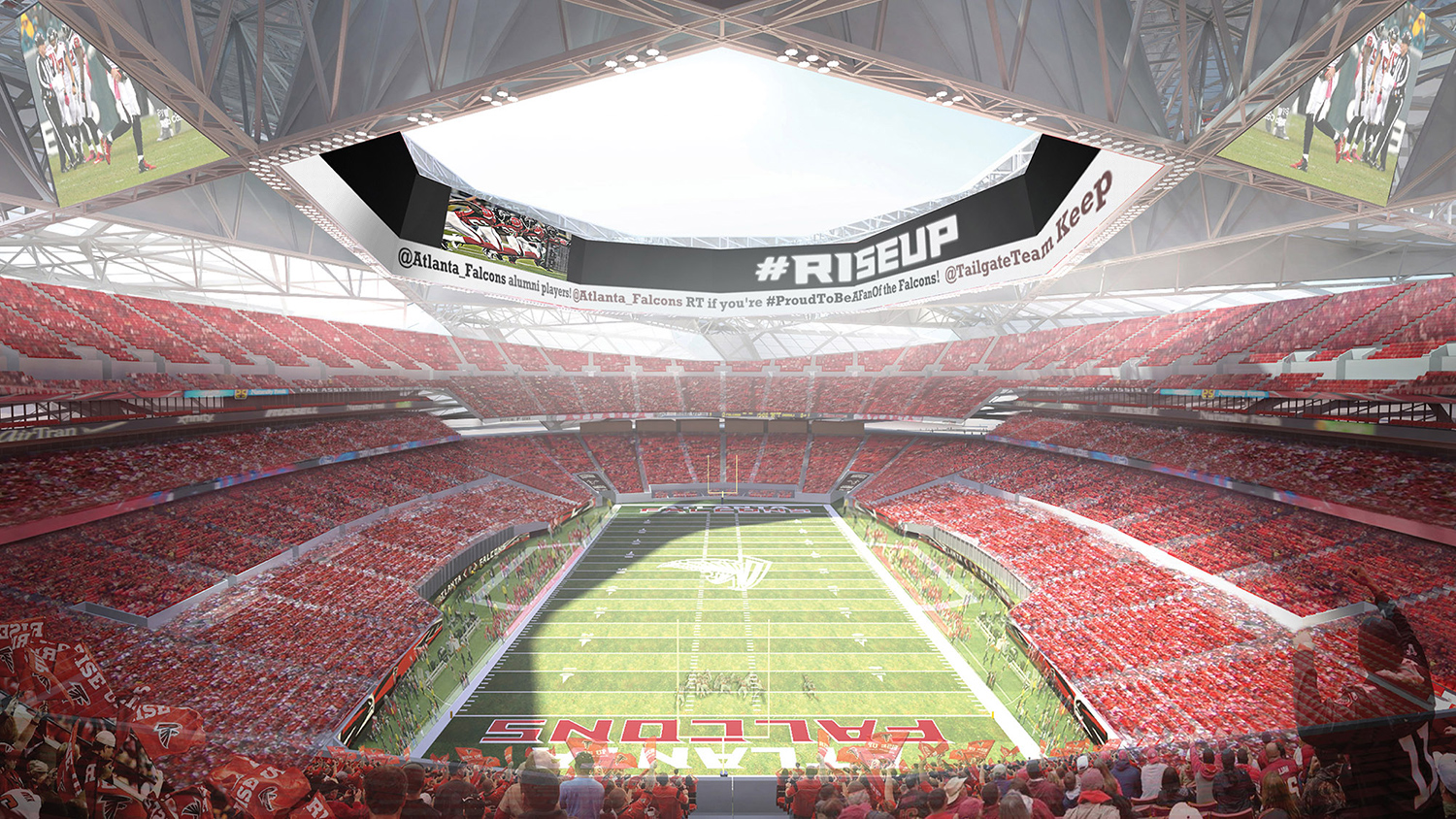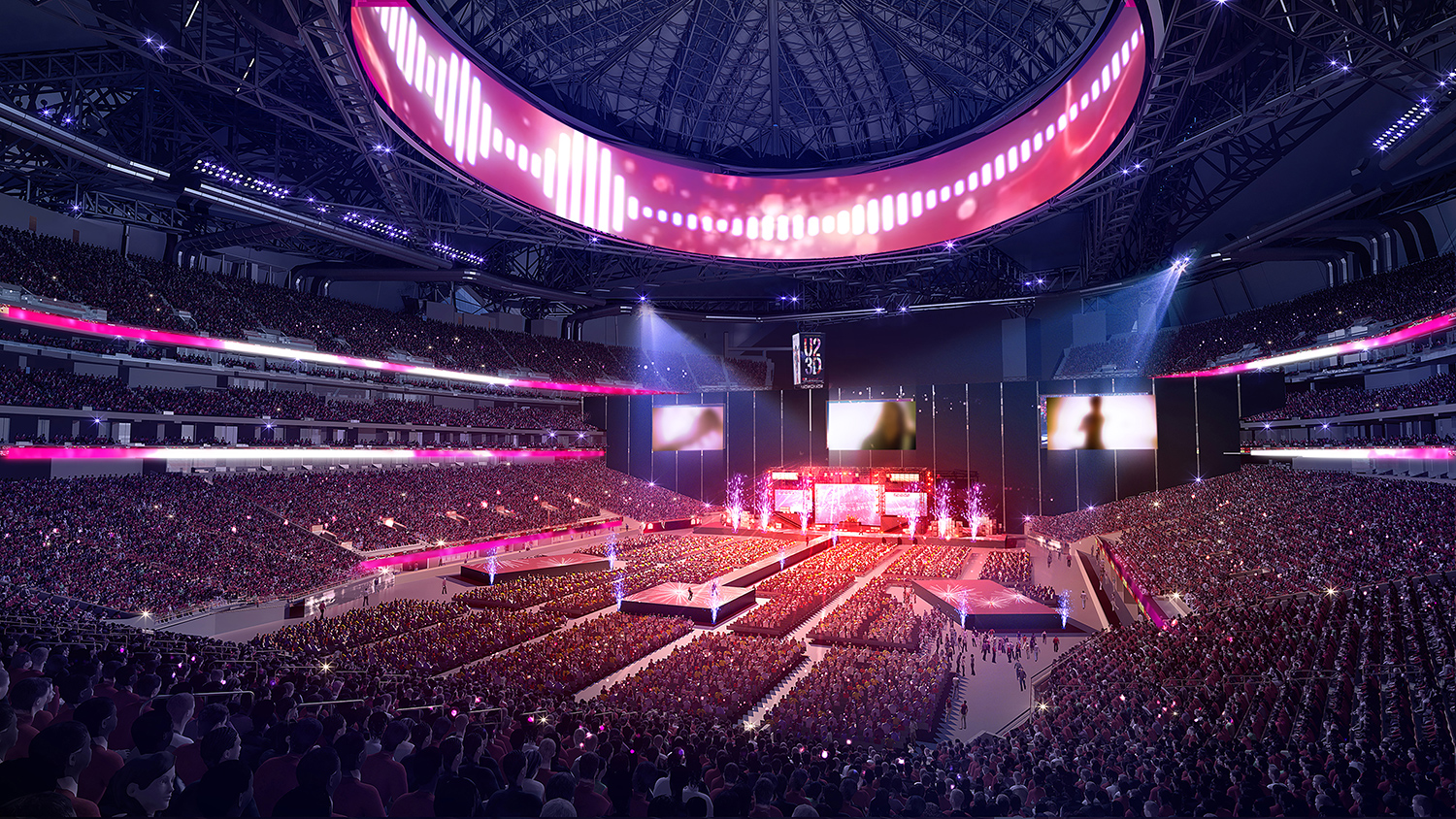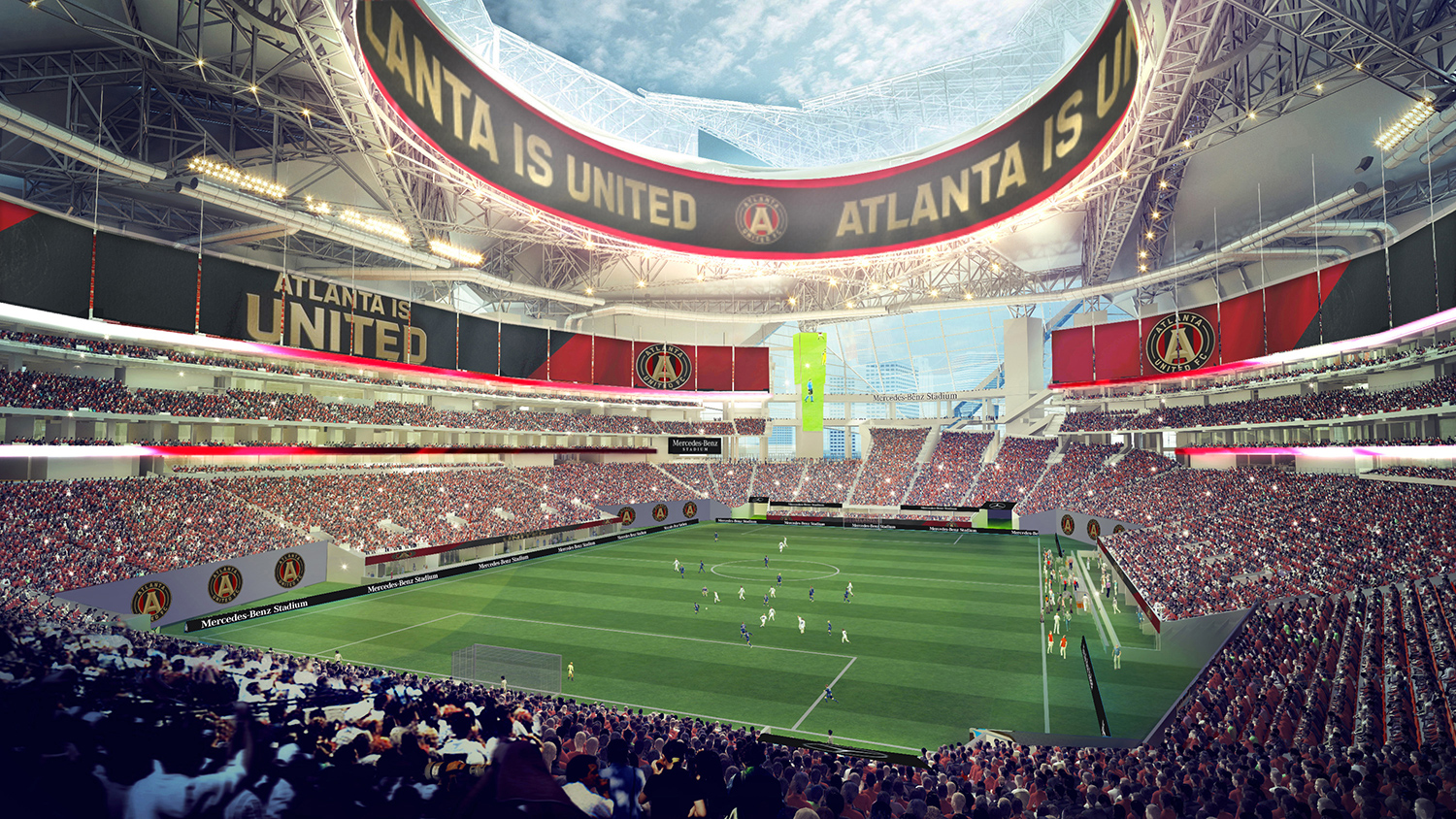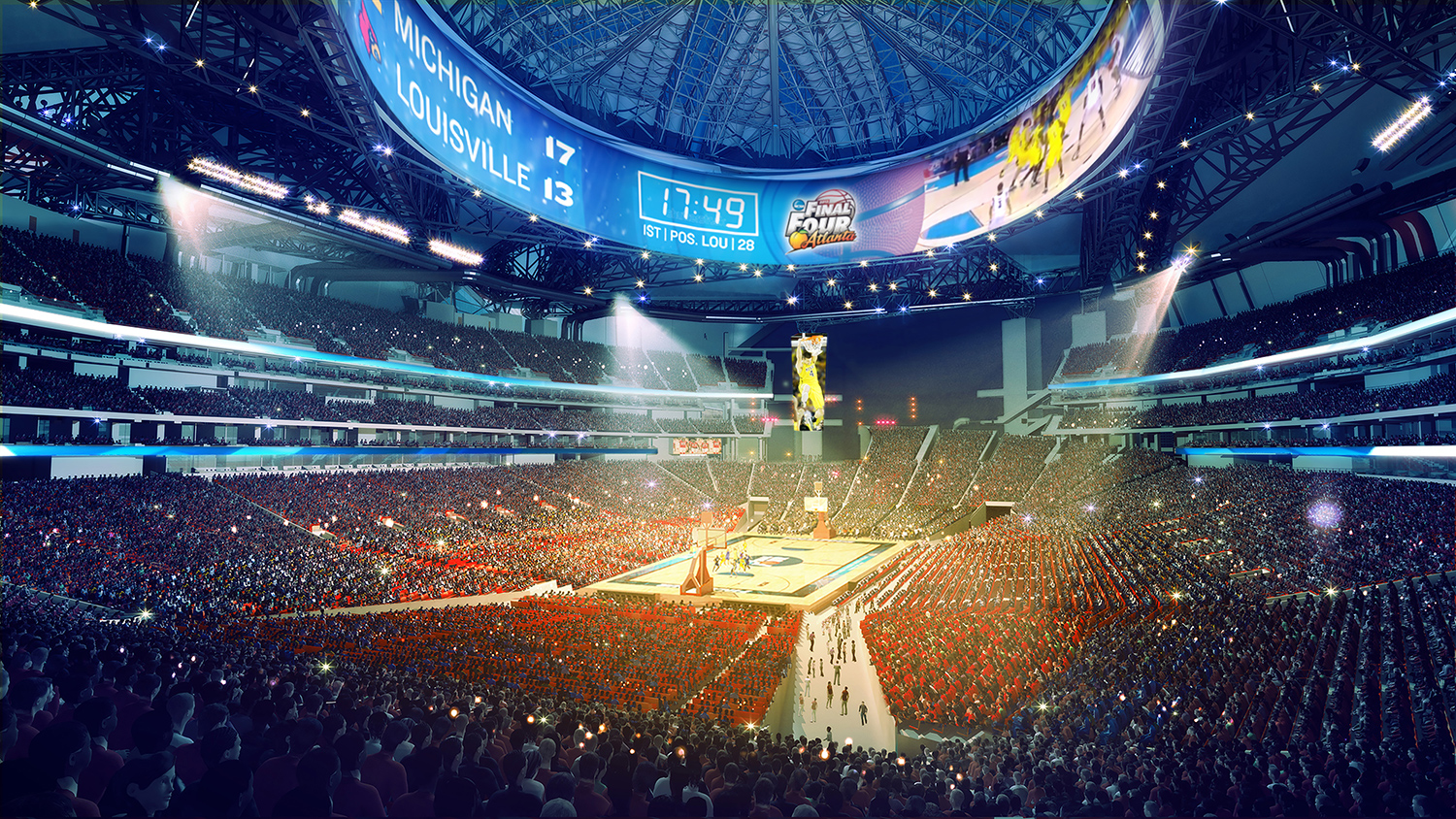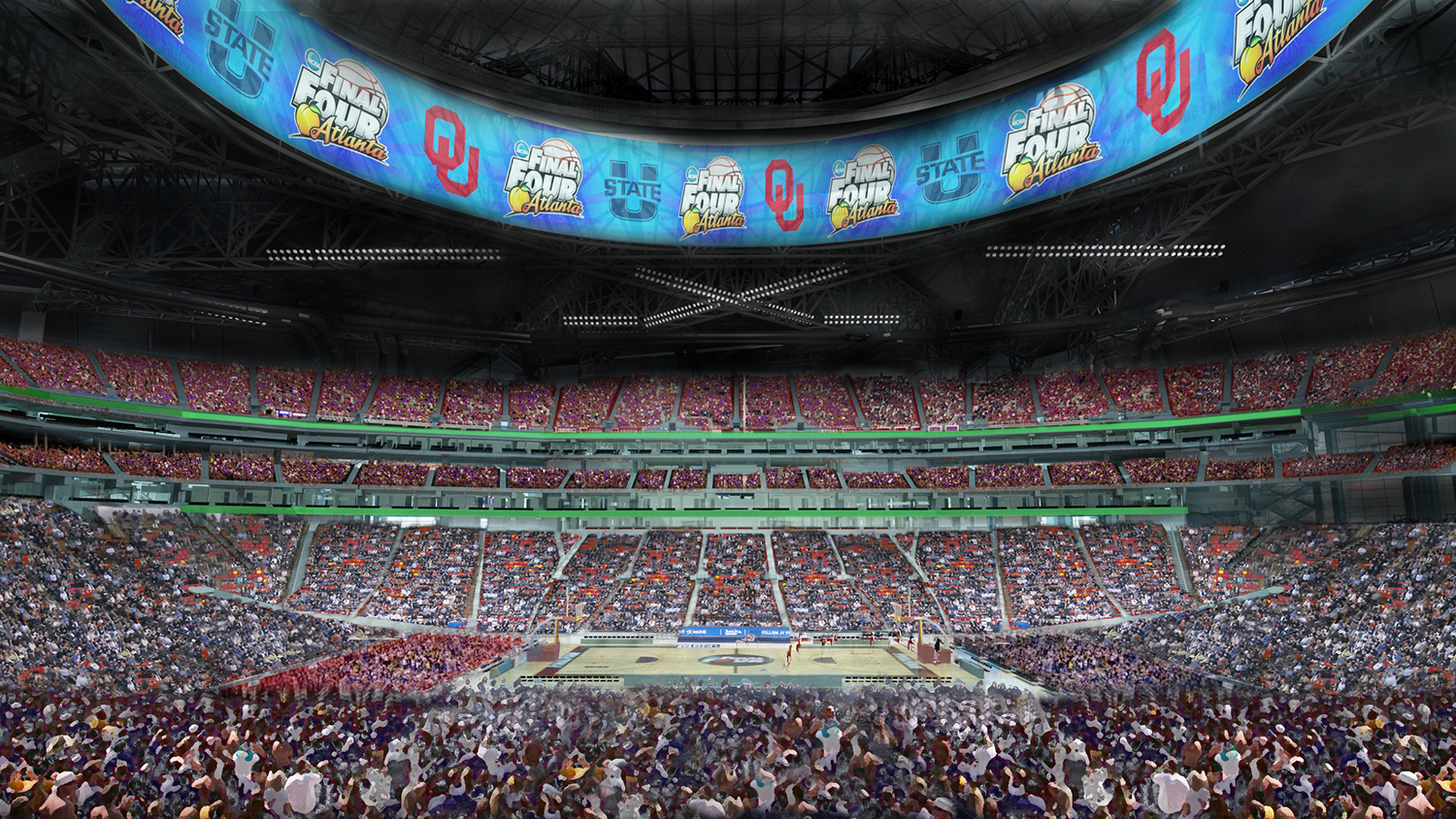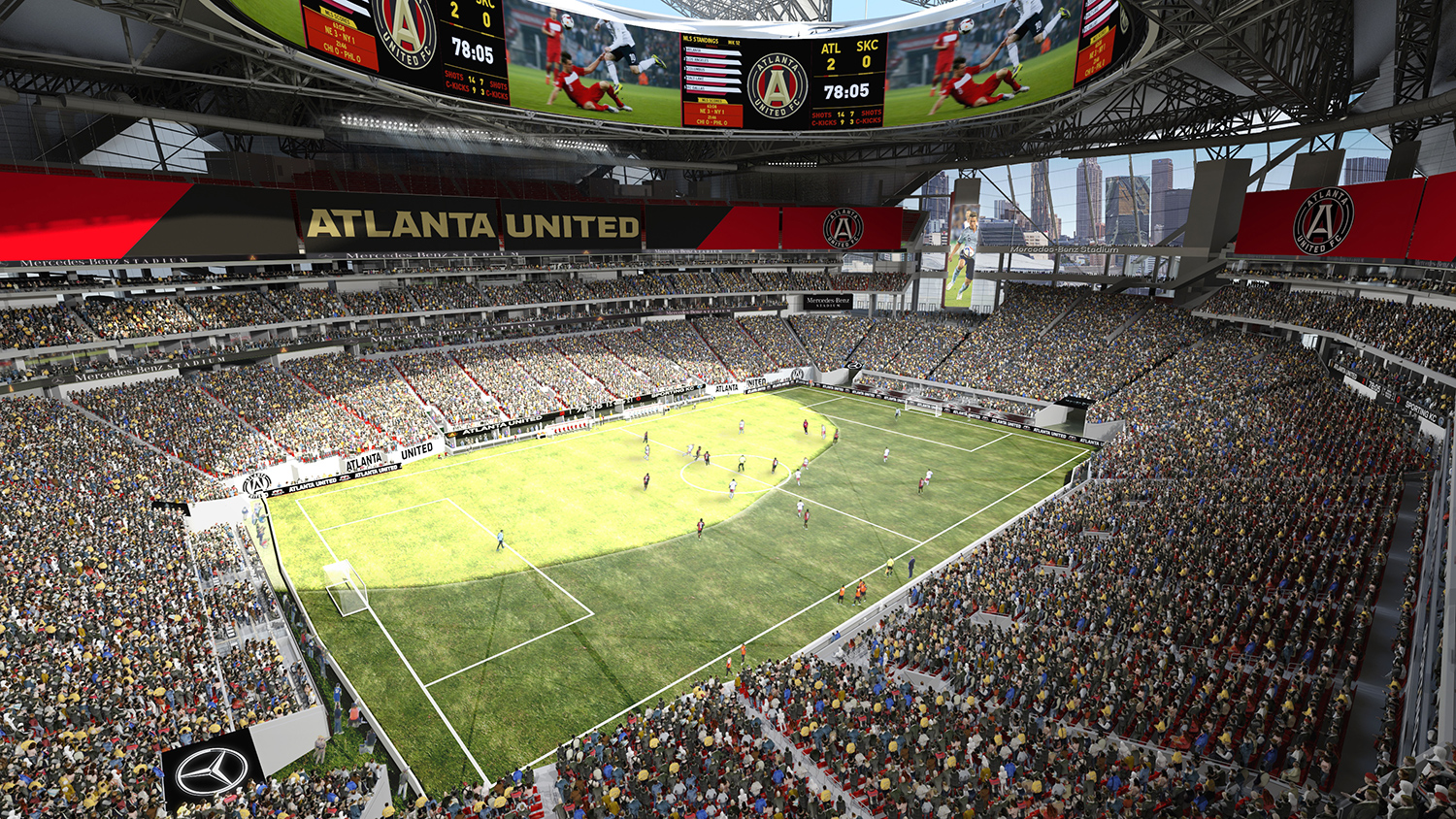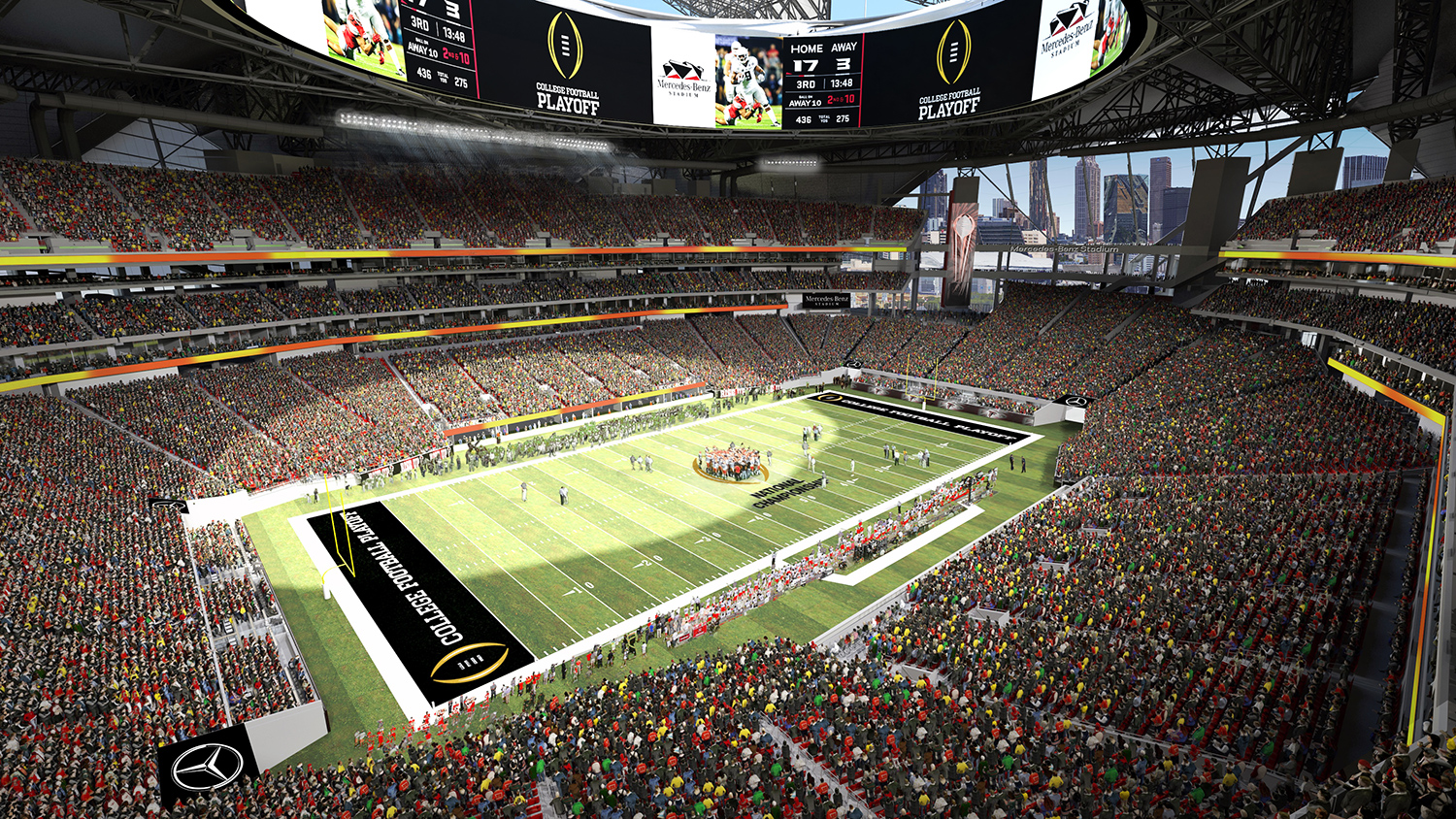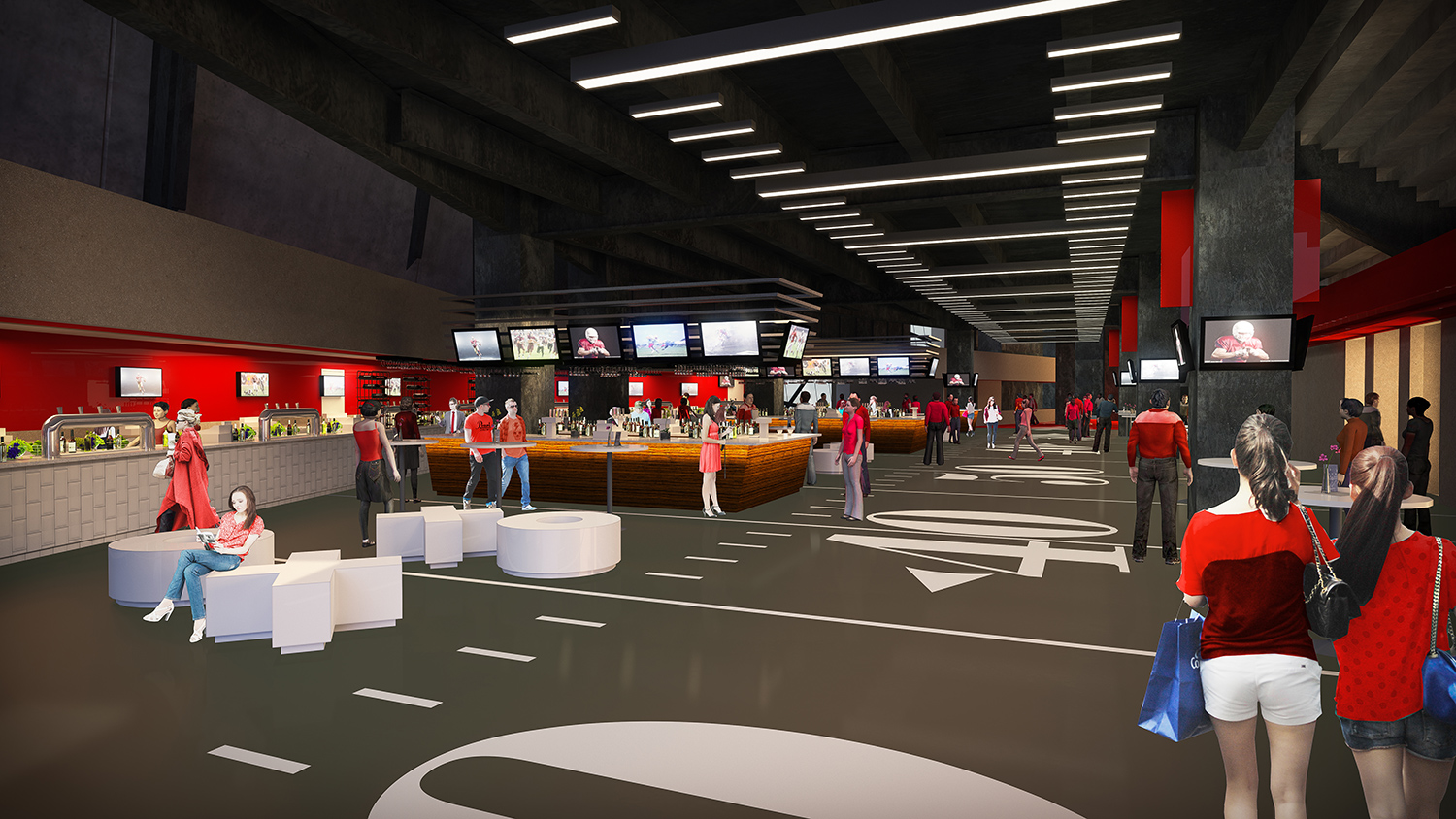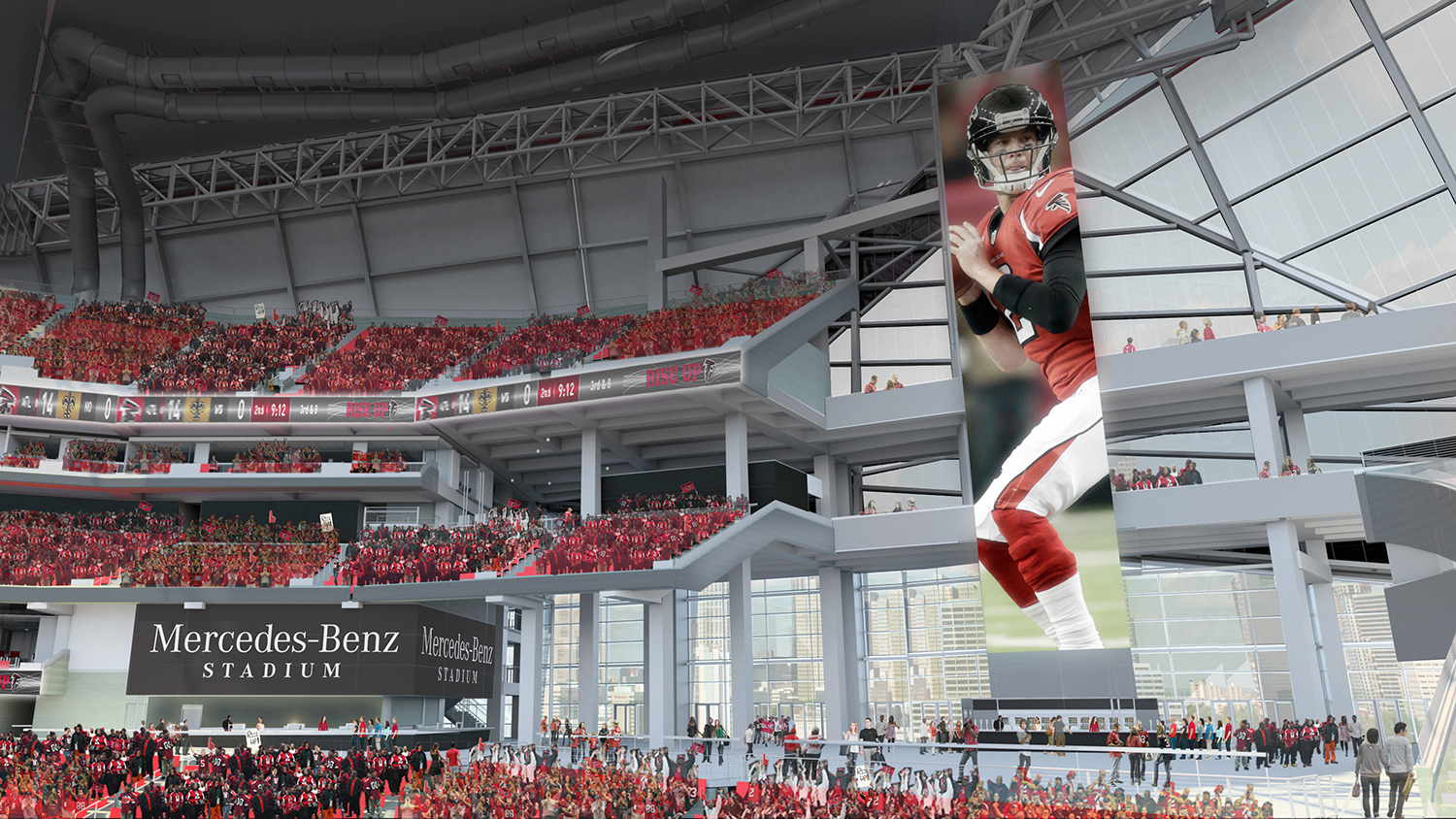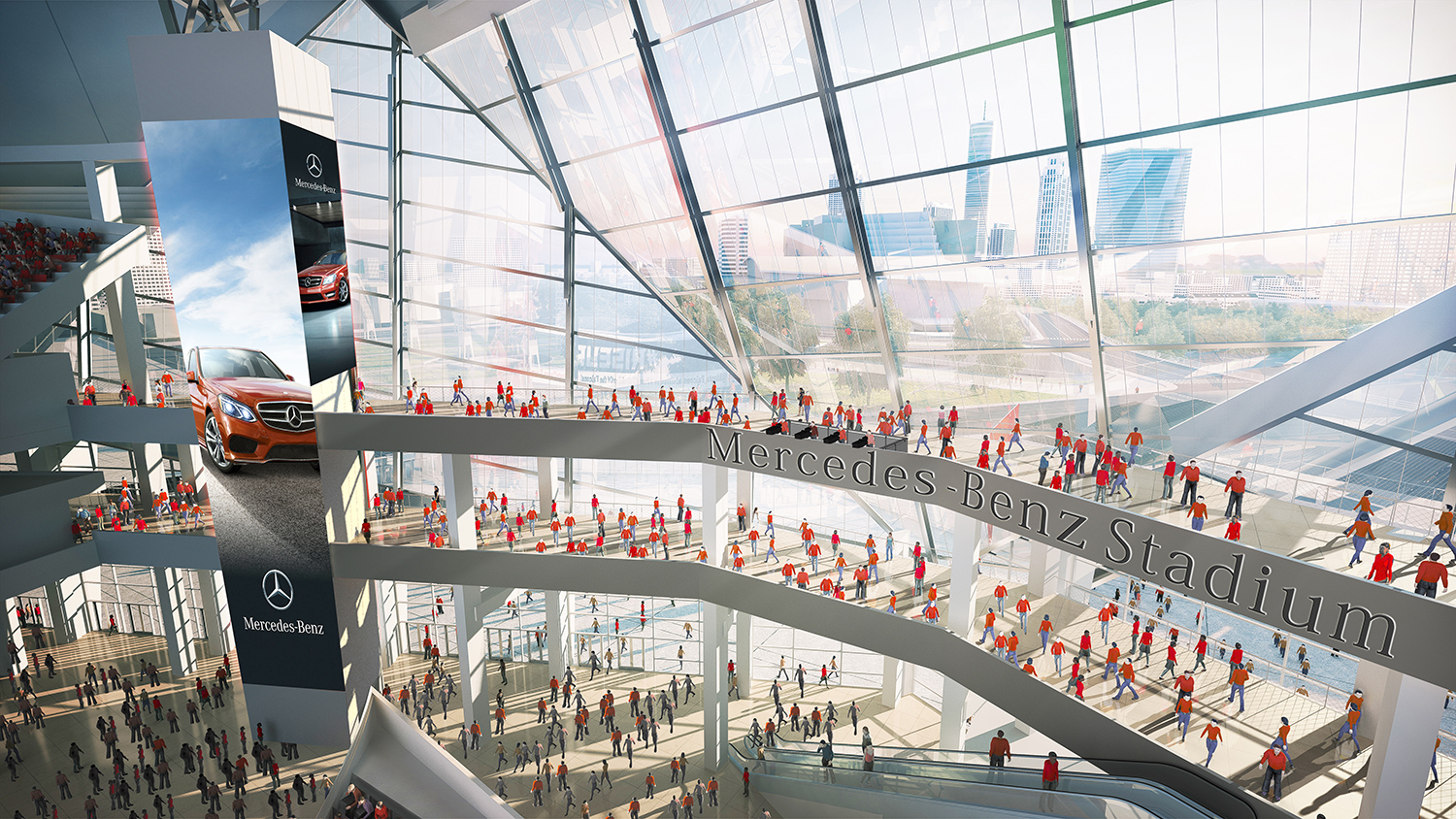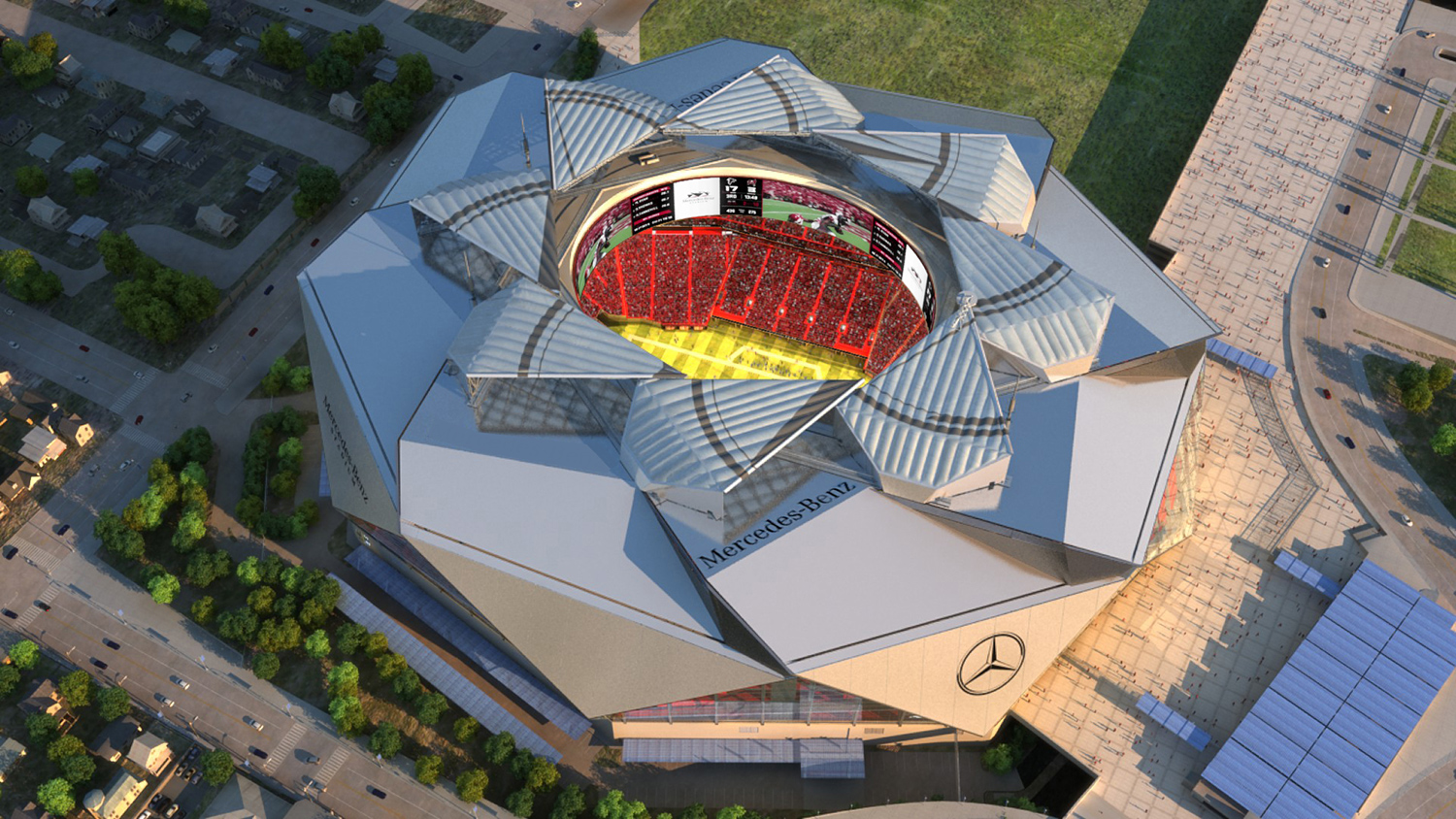When I was a grade-schooler back in the early 1980s, many a fall Sunday afternoon was spent in the den, staring at a large box with little blue-clad men running around on it. My dad would curse at Phil Simms and we’d shout a sadistic “Yes!” after Lawrence Taylor ground an opposing quarterback into the turf. So it was always big news when, once every year or so, my family scored tickets to a Giants game at the perennially sold-out Meadowlands in New Jersey, where the team played. If we could survive the sclerotic turnpike without succumbing to rage or boredom, the experience of being at the actual event, in the open air, surrounded by the awesome white noise of 80,000 cheering people, was electric.
The modern American has been conditioned not only to tolerate but to seek distraction.
But in many ways, it fell short of the living room. The repeated stops of play for commercial timeouts were far more boring and intrusive without actual commercials to watch, or the ability to easily visit the bathroom or grab a snack. In our seats, the players looked small in the distance, and the action was harder to follow without the aid of TV’s close-ups or multiple camera angles following the ball as plays unfolded. Most odd to me was the errant guy (it was always a guy) sitting near us who had a transistor radio tuned to the game. Why would you want to listen to an exhaustive description of the action when you were actually watching it in person? The constant din of a tinny voice projecting out of the little speaker was distracting.
Today’s sports arenas — and the fans who fill them — have changed in ways that the 10-year-old me never could have imagined. The modern American has been conditioned not only to tolerate but to seek distraction, to embrace a diffusion of focus. And the major professional leagues are both reacting to and amplifying this disposition. As I found out when I sampled the modern stadium experience for myself, technological distractions are built right into the facilities now — they are as critical to the structure as concrete columns and steel beams. And in 10 years, today’s live game experience may seem as quaint as listening to a transistor radio.
Take me out to the ball game
On a beautiful July night this year I attended a Wednesday evening game at Yankee Stadium. It had been many years since I went to a live baseball game, and I wanted to see firsthand how technology may have changed the experience.
How tech is reshaping how you watch at home
- Viewers want to watch sports online, and professional leagues hear their cry. The NFL, for example, now has streaming deals with Twitter, Sling TV, and YouTube, among other platforms. Each deal has its own quirks, so don’t expect every platform to stream games in their entirety … yet.
- New HDR TVs and HDR broadcasts can help even out the light and shadows, says Ken Aagaard, the executive vice president of innovation for CBS Sports, and a legend in the industry.
- “No one watches TV without a computer, or iPad, or phone on at the same time anymore,” Aagaard says. These ancillary screens could provide anything from specs to virtual reality. You watch the game on your big screen, but then use your iPad to see a specific play in VR, guiding the point of view in 360-degree space with your finger.
- Twitter is already heavily used by fans who want to “live tweet” games, making and reading others’ comments as the plays unfold. With new platforms like Blab, friends can video chat with each other while watching games alone, simulating the collective experience of watching games together in person.
- Skycams and other “floating” cameras offer sweeping overhead shots. Sophisticated graphics will be increasingly interlaid on the live action, including data from Trackman radar for golf that shows ball speed, launch angle, and club speed. Super slow motion from FOX’s “phantom cam” which records up to 5,000 frames per second, turns real-time plays into hyperreal scenes that heretofore were only in the realm of animation.
I felt technology’s influence before I even left my house, when I attempted to buy a ticket to the game with my phone. But MLB.com’s Ballpark app wasn’t up to the task. Navigating through a seating map on my tiny screen was impossible, and it wouldn’t let me pick both my section and my price. I aborted my phone and went old school – relatively — by ordering my ticket through TicketMaster on my desktop. I still had an e-ticket sent to my iPhone, where it was transferred to my wallet app. Though it’s been just a few short years since the ability to enter concerts, games, and other live events simply with your phone has become commonplace, the annoyance of having to remember or not lose a paper ticket already feels primitive.
Prior to the game, I had also downloaded the Yankee Stadium app, knowing it would offer some perks. Alas, avoiding a bottleneck at one of the stadium entrances was not one of them. Once inside, I made my way past the predictable orgy of consumerism — the endless kiosks and mini stores hawking jerseys and an array of obscure Yankee trinkets — to my seat in the back of the lower bowl, a little beyond first base.
Noticing I was sitting alone, a kindly usher tapped me on the shoulder after a few minutes and encouraged me to find an open seat toward the front. I didn’t want the confrontation of someone kicking me out of their seat, but getting closer was not an opportunity to be ignored. I found an aisle seat in the 4th row from the field and it was transformative. In the back, I was underneath the next tier’s overhang, and with the commotion of the concourse right behind me, the game felt physically and metaphorically distant. But now, with just the sky above me, I felt like I was really part of the live event. The players were so close they looked like actual people, and there was the distinct postmodern rush of seeing someone in person who’s generally only encountered on a screen. Individual blades of grass were easily discernible. I watched a plane overhead as the sky lazily approached sunset.

The relative modesty of the seven-year-old video board at Yankee Stadium doesn’t belie the supersizing arms race that’s underway elsewhere. Not surprisingly, the largest screens in succession for several years were in Texas, first in Dallas in 2009, then in Houston in 2013. Today, Jacksonville’s EverBank Field boasts two of the country’s largest, each at 362 feet wide (which is longer than the field itself), taunting Dallas and Houston on highway billboards that “not everything is bigger in Texas.” Why a colossal screen is superior to a simply massive screen is not noted in the advertisement.
You are the star
Ostensibly, fans attend live sporting events to watch the actual event unfold on the field or court. But now stadiums seem intent on not allowing fans a break to digest the action. In between innings at the game, and at each stoppage of play in every other major sport today, the assault of amusement is so dogged it seems almost defensive, as if something terrible might happen in the absence of it. Music blares, T-shirt cannons launch sartorial missiles into the crowd, games of chance to win prizes commence on the court. Video screens run commercials between innings, or zoom in on fans who spontaneously wave, dance, or smile, ecstatic at their instant and ultra-fleeting fame. The Yankee video board flashes a montage of tweeted selfies from the game and commands the rest of the crowd to use a special hashtag for a chance to get on screen, too.

Social media demands an armchair athleticism, the “I was there” culture of the medium as competitive sport. For fulfilling your sense of duty to let everyone in your feed know how great of a time you’re having at this sporting event (because there is no other subtext to a selfie at a stadium), you will be rewarded with both the envy of your followers and a chance at micro fame on the big board. The alliance of the video board and social media announces that you, the fan, are the center of this event, not the game. So today, even a game at a stadium, one of the most communal of live activities our society affords, collapses into a solipsism for its attendees.
Surprisingly, the most important information for a fan — the count of balls, strikes, and outs – isn’t overtly noticeable from my seat as I focus on the batter’s box. It’s displayed on the giant video board, but since the board is to my right, beyond center field, it’s totally out of my field of vision. Aside from the video board, there are screens everywhere, including a band running along the front of the upper deck, but it only seems to run advertisements. With my attention on the pitcher and batter, I find myself searching for this most basic of baseball stats. Finally, I find a small display that enables me to not have to turn my head away from the action.
Apps! Come get yer apps!
The Yankee Stadium app enables fans in certain high-priced sections the ability to order food from their phones and get it delivered to their seats. While the perk was sybaritic on its face, once at the game, it actually struck me as a supremely practical use of technology. Waiting in line for anything is a grind, especially if it means missing part of a game. I was surprised at how little publicized this capability was. Wanting to try out this feature, I made sure my seat was in a section designated for it. But if you didn’t already somehow know about it, and download the stadium app, and click through the in-seat delivery options before buying your ticket, this perk might as well not exist.
Paul Kapustka is an expert on the use of mobile tech in stadiums, and the editor of Mobile Sports Report, a website that intensively covers the topic. He explained to me that in many cases, the lack of promotion is intentional by stadiums because if the feature is too successful, they might not be able to handle the load. Levi’s Stadium, home of the San Francisco 49ers, has been lauded as one of the most technologically advanced sports venues today. Unlike Yankee Stadium, where information about different mobile options feels like a form of digital samizdat, Levi’s Stadium goes out of its way to promote its techie wears. A tutorial for its app is even featured on the stadium’s website. But interestingly, Kapustka said that even at Levi’s Stadium, with its Silicon Valley crowd, “If they get 3,000 orders at a football game,” that’s a lot. Stadiums need to “walk before they run,” Kapustka told me.
Also, when facilities implement fan-facing technology, the specific sport being played matters. In 2015, when the NHL held one of its outdoor games at Levi’s Stadium, as part of its Stadium Series, the mobile ordering system crashed. Because football repeatedly has stoppage of play, there are innumerable opportunities to think about and get food. But hockey, with exceptions for penalties and scores, is essentially a sport of continuous play. According to Kapustka, a mass of hockey fans tried to order food right before the period started, overloading it. At 49ers games, that scenario would never happen.
I was picking caramel out of my molars and didn’t miss a minute of the game.
Heeding the warnings on the back of every seat to “Be Alert For Bats And/Or Balls” (depending on how you look at it, either a benefit or cost of good seats), I waited between innings to order food so I wouldn’t put myself at risk of getting beaned. I opened the app and excitedly began scrolling the menu, but gradually slumped in my chair. The menu didn’t have what I wanted. Dejected, I made my walk of shame up the stairs to the concourse and waited on line with the hoi polloi at a concession stand. I missed close to 20 minutes of the game. Determined not to let the raison d’être for my seat purchase be a bust, I opened the app and ordered a package of Cracker Jack at 8:24 p.m. At 8:29, I was picking caramel out of my molars and didn’t miss a minute of the game.
A stadium built for the future
Because building stadiums and even retrofitting existing ones by necessity is performed on a massive scale and involves enormous sums of capital, the process is fairly transparent. In fact, most of the new stadiums and leagues go out of their way to boast about their forthcoming technological capabilities. So predicting where technology in stadiums is going to be in the next five to 10 years starts by looking at what’s under construction now. So I did.
The Atlanta Falcons’s Mercedes-Benz Stadium, due to open in June, 2017, will be one of the most technologically advanced stadiums in the world when it’s complete. It’s most sensational features are an oculus in the roof with retractable petals that will open and close with a camera lens-like spiral effect, and a massive, 360-degree “halo” video board. But there’s much, much more behind the scenes. I traveled to Atlanta to meet with Jared Miller, the chief technical officer of AMB Sports & Entertainment, the umbrella company that owns the Falcons and the stadium, among other assets.
From my downtown hotel window, I could see the rising complex, its naked upper beams flaunting a skeletal geodesic form. Once inside, the far-reaching corridors and cell-like rooms that will comprise concourses, back hallways, and luxury suites, where much of the venue’s infrastructure for its technology will be held, were entombed in smooth, gray concrete. Bundles of bright yellow cables laying on scaffolds hanging from the ceiling popped against the monochromatic expanse. The cables and their support structures, which looked like horizontal ladders, ran to eternity down endless halls like railway tracks converging on the horizon.
Glass arteries
These unassuming yellow cables — sheathing fiber-optic strands — won’t elicit excited blog posts or local TV news coverage like the oculus and “halo” board will, but they’re the electronic arteries of the facility. Nothing technological within this venue, or our lives in general for that matter, can exist without fiber optics, so it’s no wonder there is a litany of signs hanging from the scaffold warning “fiber optic cable, do not touch.”
The capacity of all this cable isn’t needed now, but one of the challenges for building the stadiums of tomorrow today is overbuilding tech infrastructure to handle demand in the future. The Golden 1 Center in Sacramento, California, another venue touted as being on the tech vanguard, is set to open in October 2016 and will feature 650 miles of fiber-optic cable. Mercedes-Benz Stadium will run 4,000 miles of it. His wire-rimmed glasses notwithstanding, no one can accuse Miller of shortsightedness.

While the cable is needed for many functions, most importantly, Miller wants the stadium to be ready for fans to “broadcast to the world” that they’re at a Falcons game, or the Final Four, or some other event. Increasingly, this isn’t done via text or tweet but with photos, videos, and soon, 360-degree video or 4K, which will place a massive bandwidth demand on the stadium’s network. When you’re using Wi-Fi, the term “wireless” is really a misnomer. Even though you’re untethered, the nearby hardware projecting and receiving your phone’s signal is connected via physical cables to other hardware, then on to an ISP’s lines.
To ensure strong Wi-Fi for every person, Mercedes-Benz Stadium will boast 1,800 wireless access points (WAPs) — the hardware that sends and receives wireless signals . One thousand of these units will be hidden under seats, and the rest will be dispersed in luxury suites, bathrooms, concourses, and other areas.
Mercedes-Benz Stadium will boast 4,000 miles of fiber-optic cable.
Why so many? Most existing stadiums use a limited number of overhead WAPs broadcasting in the 2.4GHz frequency band, which enables a far signal throw, but you end up with dead zones where signals are not only weak but also overlapping at the fringe of each access point,. If you’ve even seen that your phone is showing a full Wi-Fi signal but your connection is painfully slow, you’ve likely experienced this effect. Instead, Miller is planting thousands of WAPs and using the 5GHz frequency, which doesn’t extend as far, but is much stronger than 2.4GHz. Blanketing the stadium with short-range but more robust signals will translate to better speeds when you’re connected.
Yet many fans won’t even connect to this Wi-Fi. Kapustka, the Mobile Sports Report editor, told Digital Trends that 30 percent connectivity to Wi-Fi is currently considered high. Many people are still ignorant about how to connect to Wi-Fi, have unlimited data plans, or just don’t care about using up data. To increase cell capacity, Mercedes-Benz Stadium will utilize a DAS (distributed antenna system) employing more than 1,000 smaller, low-power antennas, rather than one high-power cell tower. This approach will be the norm at every major stadium in the near future, and may even outperform Wi-Fi in certain locations. As with the WAPs, fiber will string all 1,000 antennas to the “headend,” the interface that connects to the various carriers’ networks.
But the fiber-optic cable doesn’t just link to the outside. It also connects point-of-sale computers, more than 2,200 TV monitors, the halo and other video boards, security cameras, innumerable amplifiers feeding more than 3,000 speakers, and more — and it all will be expected to run lightning fast. This is where that 4,000 miles of cable starts to make sense. Miller bristles when I note that this sounds like sensible future-proofing. “I prefer future flexible,” he says, noting they’ll surely be changing stuff here at some point, too.
The details of laying all this cable get granular quickly. Each yellow cable encloses 124 individual strands of fiber. Each of those strands is capable of being fed into a splitter, and divided up to 32 times, and each one of those split strands may feed one or more WAPs and other pieces of equipment. Point-of-sale computers don’t have the same bandwidth requirements as a WAP, for example. It all seems highly precise, yet there aren’t modeled formulas at this scale — to a certain degree, Miller, and the IBM engineers who are partnered with him on the project, have to figure it out along the way.
At 63,000 square feet, the board will be 50-percent larger than both of Jacksonville’s screens combined.
As critical as fiber is, it can’t do the job alone; it only carries data. Every piece of hardware needs electricity as well. But installing traditional outlets for the thousands of pieces of equipment — from WAPs to security cameras — would be cost prohibitive. To resolve this dilemma, the fiber-optic cable will run to numerous rooms with power around the facility, where it will get spliced with copper wire, which carries electricity. This hybrid fiber-copper cable will then run to the various endpoint devices delivering both signal and power. All of these cables are being custom made by Corning — fiber is just glass, after all. In the cable, beams of light transmit digital signals through strands of glass about as thick as a human hair. Unlike fiber, copper wire can carry both data and power by itself, but after a certain distance, the signal degrades. Fiber, for all intents and purposes, has no limit to how far it can carry a pure signal. It also carries far more data than copper, and because it’s glass, it’s immune to electrical interference.
Standing in one of the concrete boxes that will become a corporate suite, Miller and I gaze outward toward several massive cranes in the center of what will become the field. Directing my attention upward toward the advancing roof structure, I envision the open oculus and the halo underneath it, like a digital collar below the stadium’s neckline to the sky. The board will be 58 feet tall and run 1,100 feet around. At 63,000 square feet, the board will be 50-percent larger than both of Jacksonville’s screens combined. (The comparison renders Jacksonville’s juvenile billboard taunting of Texas even more embarrassing.) Since it’s 360 degrees, the halo board will often be divided into sections with duplicated content shown in each section, since no individual vantage point will be able to see the whole screen. But the unique shape will also be taken advantage of with singular content programmed to run across the full screen. A new Mercedes-Benz zooming around in a circle, perhaps?
The oculus itself is but the most dazzling example of a trend of stadiums using architectural technologies to create a sort of highly managed immersion in the elements that maximizes fan comfort without them being in a sealed bubble cut off from the outside world. U.S. Bank Stadium in Minnesota, which officially opened in July, features a roof made out of ETFE (ethylene-tetrafluoroethylene), a plastic compound that enables opacity or transparency. This gives fans a sense of feeling like they’re outdoors while remaining in a climate-controlled environment. (The oculus petals at MBS will be clad in ETFE as well.) The New Miami Stadium is completing construction on a massive canopy to cover more than 90 percent of the stands, creating another hybrid indoor-outdoor venue.
Practice makes perfect
While the stadium is under construction, Miller’s team has an offsite lab that functions almost like an in-house Consumer Reports. This is where they test hundreds of pieces of equipment from vendors hoping to land contracts as the suppliers for TVs, WAPs, routers, firewalls, switches, servers, and so on. Because there is so much expensive equipment to test and sensitive information on the stadium’s servers, the lab is housed deep inside a highly secure data center.
Nearly everything the lab is testing is custom-made for the stadium.
Passing dollar stores and auto body shops on the 10-minute ride there in Miller’s Hawaiian Punch-red Tesla, we arrive at a low-rise that would go otherwise unnoticed were it not for the razor-wire fence surrounding it and the gated entry to the parking lot. The quintessence of all that is digital resides in a nondescript building next to a county jail. This is the cloud.
Not only is every item tested in the lab, but more importantly, the various pieces of hardware and software are tested together to see how they’ll all operate as an integrated system. Using simulation technology, at one point they had three stadiums running in miniature with WAPs, security cameras, point-of-sale machines, and more, all channeling information back and forth.

Nearly everything the lab is testing is custom-made for the stadium. They’re even making their own enclosures for WAPs using 3D printers on site. Once they decide on a perfect sample, a manufacturer will make them at scale. Since they’ll be underneath 1,000 seats, the enclosures are remarkable little plastic boxes, designed to withstand a beating from people kicking and spilling beer on them, not to mention the regular power washing the stands will undergo. The problem with such a secure enclosure is that electronics can easily overheat without ventilation. To solve this, each WAP has a passive heat sink that will be connected to its adjacent chair rail, diffusing the heat into the rail and essentially creating a huge heat sink. Miller assures me the chairs won’t electrocute anyone or be hot to the touch.
One of the potential luxuries that Miller is testing, which will be available only in select high-priced seating areas, are wireless chargers. After all, relentlessly sharing HD video selfies is liable to sap the battery in one’s phone.
Too much is better
One thing is certain: Though Mercedes-Benz Stadium is at the leading edge, every stadium will continue to integrate more digital technology. In one regard, this is because fans will demand and expect it. But the more tech that’s incorporated into stadiums and arenas, the more the venues will push it on the fans as well.
At Mercedes-Benz Stadium, if fans’ eyes aren’t already transfixed by the technicolor heavenly light of the halo board projecting down on them, close to another 30,000 square feet of other massive LED video boards will capture their attention on mega columns and on ribbons running along the front of various decks. The stadium has more than 90,000 square feet of video boards — more than any stadium in the world — not to mention 2,200 TV monitors (with four in each corporate suite, including one recessed in the bathroom mirror).
I asked Miller if he and his team have concerns about this all becoming a distraction. “The fans are here for the event,” he said. “We are looking to enhance that . . . though too much is not always better.”
But if a team has a highly expensive “halo” video board, it’s hard to imagine it being left blank, at least not for long. AMB Sports is looking to delight fans, and until our culture proves otherwise, “too much” is better. Thus far, fans have shown a near limitless tolerance for sensory bombardment. And as the tolerance — or perhaps better put, desire — for it increases, stadiums will continue to furnish an increasingly technologically enhanced experience in the form of evermore entertainment, diversions, and “connection.” In turn, fans will expect and demand more, creating a feedback loop of escalating spectacle.
Spectacle vs. spectacle
The most telling line in the Jacksonville billboard taunt against Texas is the tagline running along the bottom that reads: “World’s largest video boards. See it live.” Conspicuously, there’s nothing mentioned about the team in the billboard. Football is at best ancillary in this frame. Rivalry has shifted from intraleague to facility versus facility, spectacle versus spectacle. As the images and videos become more intensive and relentless, and calls for hashtagged selfies more demanding, at some point the video boards will so dominate the physical environment of the modern stadium that the game itself in some sense will be merely a sort of meta sideshow. It will become a raw material for the real event that is taking place on the big screens and the small one in your hand, of which you are the star. An argument could be made that we’ve already arrived at this point.
Increasing fans’ convenience through technology so they can focus more on the game and have less frustration is an exciting prospect.
Technology, at least in theory, is supposed to be a great equalizer. But the reality is, in early implementation, it also stratifies us, as my privilege at ordering food delivered to my seat and Mercedes-Benz Stadium’s planned wireless charging for select sections demonstrate. The best and most promising use of technology in stadiums in the next decade, some of which is being rolled out now in fits and starts, will be a more democratic offering of perks relieving so-called pain points. Through a stadium app, every attendee will be able to avoid lines upon entry and at concessions, reserve a parking spot, find out the best route to take to arrive or get home. Increasing fans’ convenience through technology so they can focus more on the game and have less frustration is an exciting prospect. Using evermore digital technology under the guise of benign “sharing” and connectivity, and to increasingly distract us from the ostensible pleasures of sport itself, is not.
By far the best element of the Yankee game for me was the result of old-fashioned, unmediated personal interaction when the usher sent me down to the front rows. For all that technology can offer to improve the experience of a live sporting event, the laws of physical space still reign supreme. Nothing beats being close to the field.










